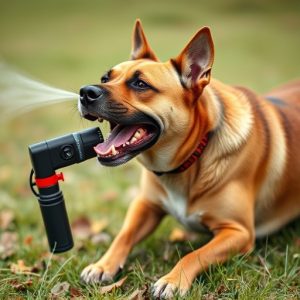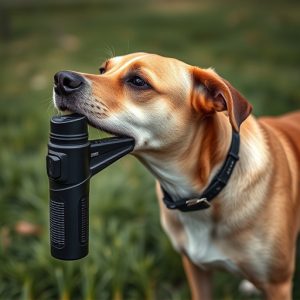Dog Spray: Effective Deterrent Using OC Percentage
Canine pepper spray, featuring oleoresin capsicum (OC) as its active ingredient, effectively deters…….
Canine pepper spray, featuring oleoresin capsicum (OC) as its active ingredient, effectively deters aggressive dogs. Higher OC percentages (20% ideal) offer faster results without harming non-targets. Additives improve performance across conditions. Potency disrupts unwanted behaviors with minimal harm when used responsibly. Pet owners should focus on OC percentage during selection for optimal safety and effectiveness against aggressive canines.
“Uncover the power of canine pepper spray—a safe and effective deterrent designed to protect your four-legged friends. This comprehensive guide explores the science behind OC (oleoresin capsicum) percentage, the key active ingredient, and its impact on dogs. Learn how this non-lethal spray works, consider essential safety aspects, and discover tips for selecting the right product. From understanding the mechanism of action to choosing the ideal spray for your pet, this article equips owners with knowledge to keep their dogs safe.”
- Understanding Canine Pepper Spray: What is it and How Does it Work?
- The Science Behind OC Percentage: Decoding the Active Ingredient
- Safety and Effectiveness: Considerations for Use in Dogs
- Choosing the Right Dog Spray: Tips for Pet Owners
Understanding Canine Pepper Spray: What is it and How Does it Work?
Canine pepper spray, also known as dog spray or capsaicin spray, is a safe and effective deterrent designed to protect against aggressive dogs. Unlike traditional pepper spray used by law enforcement, canine-specific versions are tailored to be less irritating to human eyes and skin while still causing temporary disability in dogs. This spray contains capsaicin, the chemical responsible for the heat sensation in chili peppers, which when sprayed into a dog’s face, binds to nerve endings, triggering a burning sensation and causing the animal to temporarily blink, sneeze, and retreat.
The OC (oleoresin capsicum) percentage in canine pepper spray is a critical factor determining its potency. Higher concentrations of OC ensure faster and more effective deterrence. Typically, sprays range from 10% to 25% OC, with 20% being considered optimal for most scenarios. This level provides enough punch to stop an aggressive dog without causing long-term harm or discomfort to non-target species, including humans and other pets. The spray’s formula also includes various additives designed to enhance its performance, ensuring a consistent and reliable effect in different weather conditions.
The Science Behind OC Percentage: Decoding the Active Ingredient
The effectiveness of canine pepper spray lies in its active ingredient—OC (Oleoresin Capsicum) percentage. This crucial metric refers to the concentration of capsaicinoids, the compound responsible for the burning sensation associated with chili peppers. Each can of dog spray has a specific OC Percentage, typically ranging from 10% to 25%. The higher the number, the more potent the spray, ensuring it serves as a powerful deterrent against potential threats.
Understanding the science behind OC Percentage is key to choosing an appropriate defense option. Manufacturers carefully calibrate this percentage to balance safety and efficacy, guaranteeing that the spray will cause temporary but effective disorientation without causing severe harm. This precise formulation allows owners to protect their pets with confidence, knowing that the spray is both safe for use and highly effective in scaring off potential aggressors.
Safety and Effectiveness: Considerations for Use in Dogs
Dog spray, also known as canine pepper spray, is designed to be a safe and effective deterrent for managing unwanted behaviors like aggression or wandering. When considering its use, it’s crucial to understand both the safety profile and effectiveness in dogs. Canine pepper spray contains capsaicin, the active ingredient found in chili peppers, which irritates the eyes, nose, and throat when inhaled. The OC (oleoresin capsicum) percentage in dog spray varies but typically ranges from 2% to 5%. This concentration is low enough to be safe for dogs while still providing a powerful deterrent.
Studies show that dog spray can quickly disrupt and stop aggressive or potentially dangerous behaviors, often with minimal physical harm. However, it’s essential to use it responsibly and follow manufacturer guidelines strictly. Safety precautions include ensuring the spray is out of reach of children and pets other than the targeted dog, using it in well-ventilated areas, and being prepared for potential side effects like temporary blindness or difficulty breathing. Effectiveness can be enhanced through positive reinforcement training after the initial deterrence to reinforce desired behaviors.
Choosing the Right Dog Spray: Tips for Pet Owners
When considering a dog spray as a deterrent, pet owners should look beyond just the brand and turn their focus to the active ingredient and its concentration. The most common active ingredient in canine pepper spray is oleoresin capsicum (OC), measured in percentage. A higher OC percentage indicates a stronger spray, offering more protection against potential threats. Opting for a product with at least 98% OC ensures maximum effectiveness in deterring aggressive dogs.
To make an informed choice, read product labels carefully and compare OC percentages. Keep in mind that a higher concentration doesn’t always mean better; it’s about finding the right balance. Additionally, consider factors like spray pattern, range, and ease of use. Testing the spray in a controlled environment before an emergency is also advisable to ensure its reliability.
Dog spray, particularly those with a high OC (oleoresin capsicum) percentage, can be an effective deterrent for aggressive dog encounters. Understanding the science behind OC and its safety profile is crucial for responsible use. By choosing the right product and considering individual dog needs, owners can ensure a safe and positive impact on their pet’s well-being while providing a reliable defense mechanism in potentially dangerous situations.


